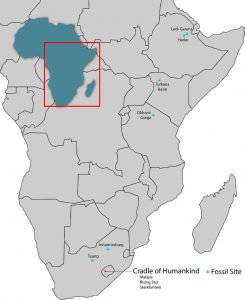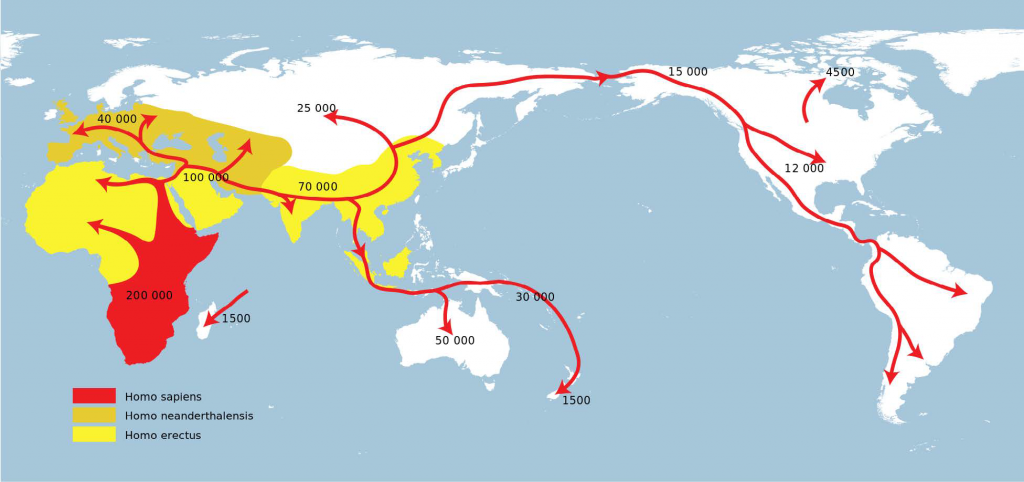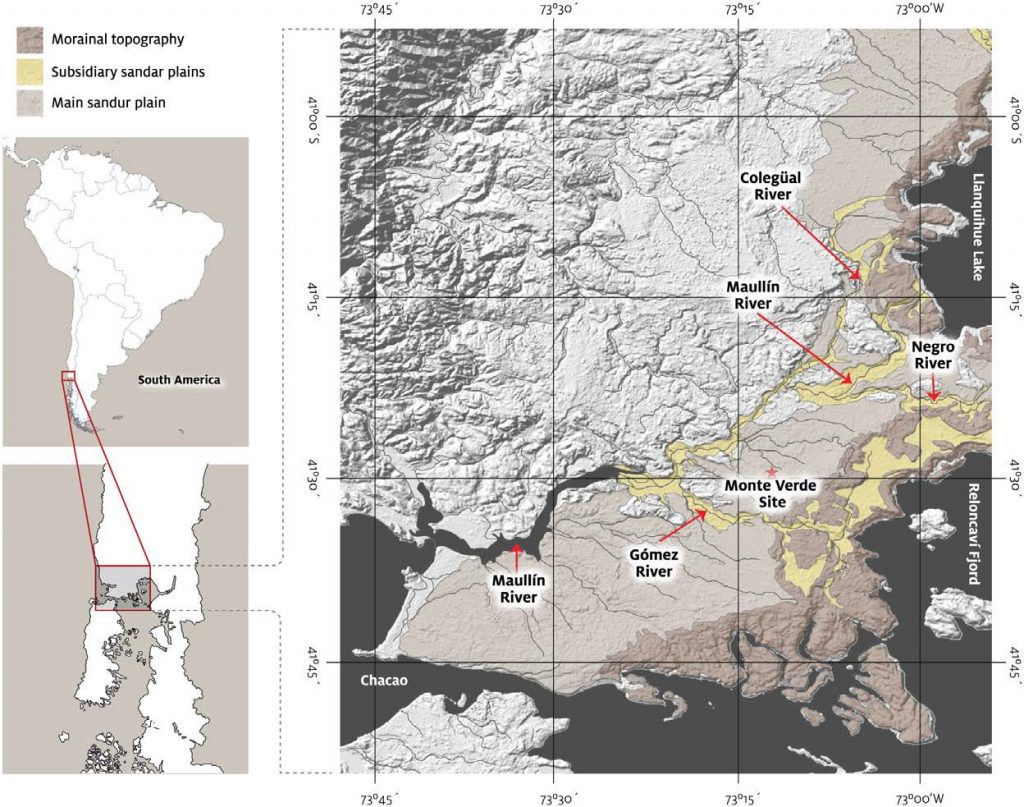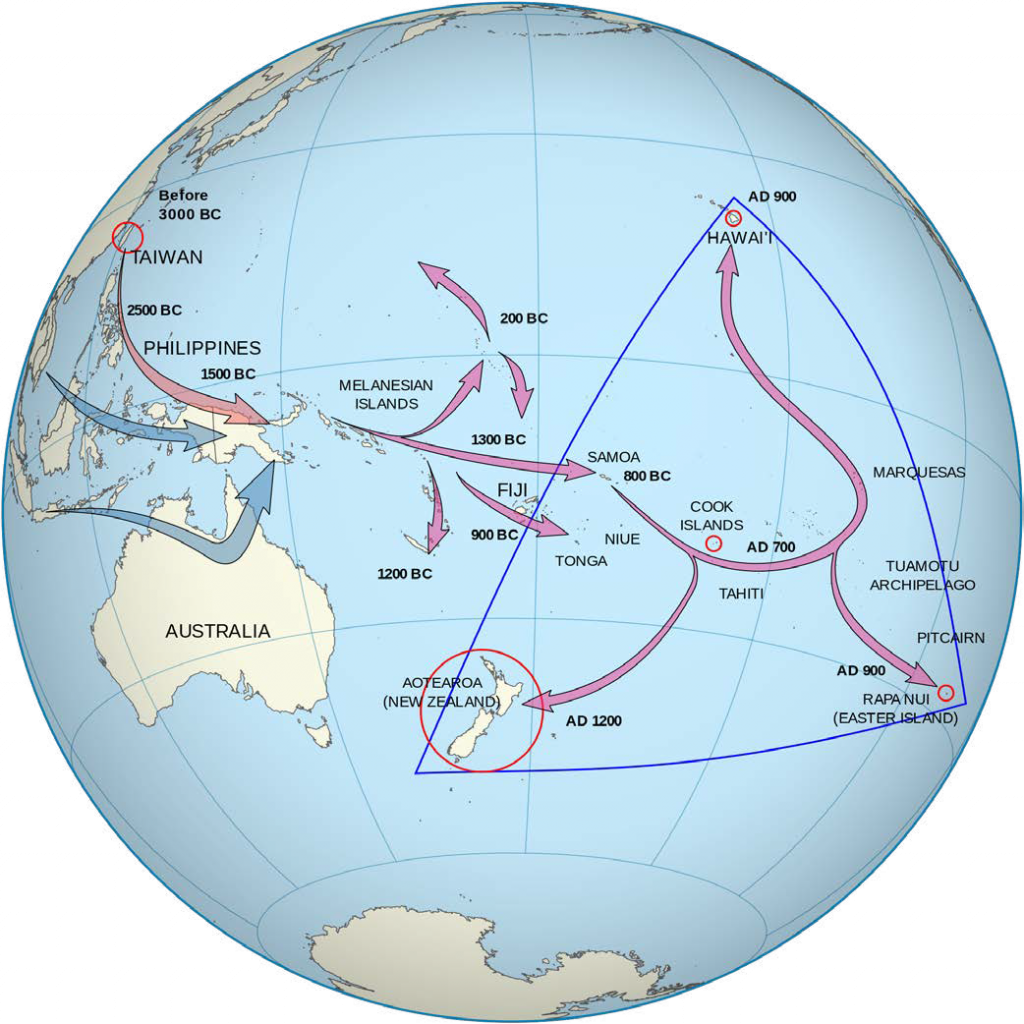Human Beginnings in Africa
Human Beginnings in Africa
The fossil record in Africa clearly establishes that a human lineage diverged there from African apes sometime between eight to six million years ago. Beginning as far back as eight million years ago, various species of hominids (the ancestors of modern humans or Homo sapiens) began to walk upright. This bipedalism would allow these hominids to use their hands to develop, craft, and use tools. Bipedalism would also eventually contribute to a move out of forests into the savanna and turn hominids into big game hunters and gatherers. Paleoanthropologists once theorized that hominids became bipedal to adapt to life in the grasslands. However, the fact that fossils of bipedal hominids were found alongside fossil remains of wood, seeds, and other forest dwellers has cast some doubt on that theory. In fact, bipedal hominids may have lived in the forest for some time. While some bipedal hominids may have stayed in the forest, climate changes did drive others to move into new areas within Africa and beyond it.
Climate, Hominin in Evolution, and Migrations
As far as thirty million years ago hominids were reacting to changes in their environment. (“Hominids” refers to all Great Apes including humans and their ancestors. “Hominins” is often used when speaking more specifically about modern humans and their more recently extinct ancestors. We will use “hominids” here because it covers all of the groups we will reference including modern humans). The earth cooled, producing more fragmented environments. As already mentioned, some hominids may have stayed in the trees, but those that left the forest began to thrive in grasslands. These savannas and prairies expanded during the Miocene, the geologic era lasting from 24 – 2 million years ago. This grassland expansion prompted baboons and hominids to move out of the forest.

During the Pliocene epoch (5 – 1.6 million years ago), another series of environmental changes made these grass- lands even more prevalent, leading to a transformation that geologists call the “turnover-pulse hypothesis.” Animals with adaptations such as angled knee joints and arched feet survived on the grasslands, while those with longer arms or curved fingers who were better suited to the woodlands did not. For hominids, this favorable grassland environment meant the “development of several closely related species. Large-toothed hominids known as robust australopithecines appeared in Southern and Eastern Africa.”[1] Towards the end of the Pliocene, around 2.4 million years ago, the first members of our genus—homo (Homo habilis)—appeared, the first hominid to make stone tools.
The Pleistocene epoch (1.6 million – 10,000 years ago) saw at least twenty-five periods of glaciation and warming. Glaciation resulted from dips in global temperature which had two major effects on hominid development. First, with sea levels dropping due to glaciation, hominids migrated to Australia and the Americas for the first time. Second, while many migrated out of colder climates, those that remained developed physical adaptations. Homo neanderthalensis (Neaderthals), a hominid that disappeared 28,000 years ago, became stockier and more powerful to deal with the difficulties of this icy climate.
While not as dramatic as previous developments, the current Holocene period has seen its share of significant climatic events. The Younger Dryas event (c. 12,000 BCE) was a drop in global temperatures accompanied by a corresponding change in vegetation distribution. Reduced rainfall from 2200 – 1900 BCE made conditions very difficult for civilizations in the Eastern Mediterranean. Finally, the Medieval Warm Period represents “one of the most recent periods of climate change.”[2]
Like neanderthalensis, Homo sapiens, Homo erectus, Homo habilis, and other hominids all reacted to changing climate conditions. Homo erectus and Homo habilis migrated, hunted, and used fire, while neanderthalensis had some use of language and tools and buried their dead. For millions of years, in fact, hominids had been using slivers of volcanic stone and cutters probably to hack through animal skin. The cutters were often found close together, suggesting that early hominids even had a division of labor between hunters who would have to pursue their prey and butchers who could wait nearby at the butchering site. There is even evidence of task division by gender among neanderthalensis. Multiple sites in Europe show different patterns of wear on male and female teeth, indicating a gendered task division in tasks where teeth were used to hold, break, or strip objects.[3]
However, by 25,000 years ago all other hominins were extinct; only Homo sapiens sapiens, our species, survived. Paleoanthropologists attribute this survival to larger brains, durability, and ability to adapt to changing environmental conditions. Based on migration patterns and archaeological evidence, Homo sapiens sapiens appear to have been the only hominids to build sea-worthy boats, create art, have organized religion, and live in any climate.[4]
Homo sapiens Migration
While Homo sapiens were decidedly more advanced than other hominids, when they first moved out of Africa some 45,000 years ago, they were only equipped with stone tools for hunting and cutting. Despite those initial limitations, 30,000 years later Homo sapiens would inhabit almost every environment on earth and had a presence in every continent except Antarctica. Homo sapiens in fact moved further and faster than all other hominids. While it is hard to attribute a single factor to all Homo sapiens migration, we do see that multiple human societies required migration to arrive at a more sophisticated level of development. Homo sapien migration accelerated close to 40,000 years ago, where humans reached continental Eurasia.

Modern humans (50,000 – 10,000 years ago) completed the migration to all the continents except Antartica, moving first into Australia, Eastern Siberia, the Pacific margins, Japan, and the Americas. Then from 10,000 years ago to 1,500 CE, humans arrived in the Arctic, the Indian Ocean, the deep Pacific, and tropical rain forests. Migration occurred in a “staccato” pattern with “easiest” areas colonized quickly, while more “difficult” areas remained uninhabited for thousands of years. A region’s “easiness” is calculated from estimates about available plant and animal biomass and net productivity—that is, how quickly it returns—in each habitat. For example, tropical savannas and grasslands of East Africa were colonized first as the biomass there sustained the first bipedal hominids.
Hominids first left “sub-Saharan Africa … through the northern savannahs, up the Nile corridor or across the straits of Bab el Mandeb to the Arabian Peninsula.”[5] Evidence exists of Homo erectus in Morocco, Chad, and Algeria, and it appears that they eventually left Africa via the Arabian Peninsula. After leaving Africa about 1.5 million years ago, choppers, handaxes, and spheroids found at sites like Ubeidiya in Israel put Homo erectus in the Levant. Some scholars argue for the existence of a second migration out of Africa and into the Jordan Valley 500 to 600 thousand years ago.
Asia
Some evidence suggests the presence of Homo ergaster and Homo erectus as having occurred in Java over a million years ago. Chinese Homo erectus fossils date between 800,000 to 400,000 years ago. Homo sapiens began to leave Africa around 40,000 years ago, and hunter gatherers appeared in China by the end of the last Ice Age (36,000 to 16,000 BCE) as continental ice in central Asia began to melt.
Europe
Animal bones and pebble tools place hominids near Rome just before the beginning of the Middle Pleistocene (730,000 years ago). This seems to be the first hominid incursion into Europe. Hominid remains in Spain suggest colonization in Iberia up to two million years ago, but there are not nearly enough remains (no more than twenty inhabitants in any given site) to provide any certainty in terms of which hominids they correspond to or when they lived there. Either way, colonization of Europe can be considered “late.” This tardiness may have been related to a lack of animal food sources. Not until around 500,000 years ago did “new species of deer, bovid, rhino, and horse appear”[6] in Europe. Around the same time, the cheetah, saber-tooth tiger, and dirk-tooth cat declined in the region, making more carcasses from the aforementioned species available to hominid foragers.
Australia, Papua New Guinea, Sahul
Evidence of tools from 30,000 years ago exists in Australia, and from even longer in New Guinea. The lack of “a dry land crossing to Sahul” (the land mass that once connected New Guinea and Australia) meant that an ocean journey of somewhere between sixty-five and 100 kilometers was required from mainland Asia. This made Australians and New Guineans the first sea-going colonizers. Once in Sahul, how humans populated Australia is still the subject of some debate between those who support the “coastal hugger” theory and those who support the idea of population by “overlanders.” The more difficult of the two means of populating Australia is overland, as it is more arid than the coasts, and the evidence for tools overland is not as advanced as that for the coast.
Peopling the New World
North and South America were the last continents to be settled by humans. Most scholars think that the Americas were populated from Beringia over land. Around 12,000 years ago, mammoth hunting became more common and supported larger populations on both the Asian and American sides of Beringia, a landmass (now divided by the Bering Strait) which at that time connected North America and Asia. On the Asian side, outlines of houses with stone-lined hearths have been found, remnants indicating permanent settlement that didn’t necessarily have colonization as an end goal. But colonize they did, one group pushing southward between 10,000 and 3,000 years ago and establishing settlements that would become the origins of modern Korean, Japanese, Chinese, and Inuit populations. Another group migrated southeastward through Alaska, their descendants making it as far as Chile and Argentina.
While we know about when American colonization began, the pace and means of colonization are still debated. Complicating the discussion of timing is the fact that the Late Wisconsin Ice sheet blocked the overland route from about 30,000 years ago, when two sheets merged, up until about 12,000 years ago, when they opened after a thaw. At this point in time, only a handful of sites support possible pre-10,000 BCE occupation: Monte Verde in Chile, Meadowcraft near Pittsburgh, and Page-Ladson in Florida. As recently as 2015, excavations at Monte Verde and Chinchihuapi have strengthened the “possibility of an earlier human presence on the continent” to as far back as 17,000 BCE. This date has continued to move back in time as archeologists consider evidence of more mobile humans who did not leave large artifact clusters because of their ephemeral nature, but nonetheless may have been present before more sedentary groups.
For now, however, the clearest evidence for when the Americas were widely populated comes through the Clovis point, a specific arrowhead shape that was unique in its ubiquity and sophistication. The Clovis point was also found in mammoths that had grown extinct by 10,500 years ago, this discovery meaning that humans were common in North America by then. From Beringia, humans moved at a rate of roughly 10 miles a year until they reached Tierra del Fuego and fully populated the Americas (with the exception of some tropical areas mentioned above).[7]

The Arctic
The first Paleo-Eskimo populations appeared around 4,000 years ago after arriving from Eastern Siberia, populations that were left behind by the American colonists already mentioned. The Arctic climate is harsh, to say the least, and these populations needed sophisticated weapons and tools to be able to survive it, which explains their late arrival. The Arctic colonists expanded rapidly across Alaska, through Canada, and into Greenland, assisted by their arctic “small tool kits” that included the important toggle headed harpoons to kill walrus and seal.
Polynesian origins
The origins of Polynesian humans are still very much in doubt. Groups of Polynesian mariners had existed 50,000 years ago, but they were not colonizers. In fact, many scholars argue that eventual colonization actually began as exploration. Around 2,500 years ago, we see more permanent settlements in Fiji, Tonga, and other areas of the “remote” Pacific, as remnants of pottery have been found there. Based on linguistic and technological similarities among Polynesian cultures, some scholars argue that Fiji, Somoa, and Tonga were a crucible of sorts where Polynesians were “made” from groups from throughout Asia. Once these cultural groups had a certain identity, they began to colonize Easter Island, Hawaii, and New Zealand about and beyond 1,000 CE.

We can’t use land migration patterns to understand oversea migration. The Pacific was somewhat of a highway, where currents and winds were well- known and frequently used by mariners. Migrating humans were much more likely to wander aimlessly on land than they were to let currents take them to unknown parts of the ocean. Pacific mariners tacked to use the winds in their favor and, despite population pressures, Pacific mariners were too adept at seafaring to suggest a simple casting out of people into the Pacific in hopes of finding something. Once Pacific colonization did commence, settlers were very deliberate about it, taking with them families, and plants, and animals. It seems that they had every intention of recreating “home.” In sum, the exploration was neither extremely heroic nor extremely risky but instead was calculated and not left to chance.
Hunter-gatherers
Chapter Two explores the importance of farming to the creation and expansion of early civilizations. However, farming was only invented 13,000 years ago, meaning that for most of human history, our food has come through foraging. Early hominids like australopithecines, Homo habilis, and Homo erectus ate mostly plant food. Homo sapiens became more sophisticated foragers as they began to fish with hooks and, more recently, nets, and as they used stone grinding tools to produce flour.
As food gathering techniques evolved for these Paleolithic foragers, so did their behavior as organized groups. Modern humans became mobile to prevent resource depletion; they controlled population through dispersion or infanticide, and they began to “live and work cooperatively.” Modern foragers also began to divide tasks and share food with others, a feature that distinguishes them from other animals like chimpanzees that live in communities but feed individually. Sharing food is, of course, much easier to do when there is a surplus, and, with increasing tool use, Paleolithic humans became even more adept at foraging, leading to the higher likelihood of food surpluses.

Tool use not only helped humans live cooperatively, but it also may have helped hominids develop abstract thought—evidence of tool use may give us a clue as to when this development began. We know that other animals use tools, but even as long as 2.6 million years ago, we see evidence of the creative thinking required to make more effective tools. Homo habilis in fact takes its name (“handy man”) from the fact that they were the first known hominid tool-makers. Soon after individual tools appeared, the Oldowan Industry became the first widely used toolset, “consisting of flaked and smashed quartz riverside pebbles made into poorly formed choppers and sharp stone flakes, [and] lasted for 1 million years with little change [from 2.6 to 1.5 million years ago].”[8] The Oldowan were followed about 1.5 million years ago by hand axes that remained unchanged for more than a million years. Many scholars argue that these smaller-brained hominids like Homo habilis, homo ergaster, and Australopithecus were both unable and unwilling to innovate much beyond their simple but effective tools, especially considering how harsh their environment could become. Fire was another important tool, first used by Homo erectus about 1.6 million years ago. Fire would become important to migrants to colder climes in Europe and Asia and to foragers who could now eat foods that were poisonous if ingested raw. Homo erectus also cooked foods they had previously eaten raw, thereby expanding their lifespan by eliminating toxins found in raw meats.
Homo sapiens would add more meat to their diet when advances in tool-making led to an increase in big game hunting during the late Pleistocene. For example, excavations near Dolni Vetoniçe in the Czech Republic have helped reveal a society that “used mammoth remains not only for meat, but for fuel, construction, jewelry, and portable art.” The inhabitants of Dolni Vetoniçe also made thousands of ceramic figurines, bird bone flutes, and ivory carvings of human heads. The cave paintings of Lascaux also reflect this increased skill as hunters and painters both. The colors and types of paint they used were vibrant and durable, and the scenes they depicted demonstrated their use of diverse hunting techniques. There we see depictions of humans hunting not only deer, but also woolly rhinoceros and mammoths.
Also at Lascaux, we see evidence that hunter-gatherers had both religious beliefs and gender specific tasks, reflecting a sophistication that we usually only attribute to sedentary humans. The fact the humans and animals were depicted together so often at Lascaux may be evidence of a belief that man descended from these animals. Or perhaps the bison, rhinoceri, and birds were painted on the walls to produce “hunting magic” designed to make expeditions more successful. Finally, it was mostly men depicted in these higher-risk hunting activities, suggesting that women were the artists, participated less in the hunt, or both.
Closer to the Neolithic era, societies began to experience a growing role for women reflected through their representation in “Venus” statuettes. (See Figure 1.5) As we get closer to the Neolithic era, we see the relative role of women increasing; their place in ritual increases, their stature increases, their economic importance increases, and their childbearing uniqueness becomes more greatly emphasized.
Increased sophistication was not limited to big game hunters, however. Campsites, rock art, and burial sites near Lake Mungo in Australia reveal how these early humans used pottery for cooking and had a diverse diet of birds, fish, and shellfish, a diet that seems to have kept them well-nourished.[9] Australia was a society of hunter-gatherers until European colonization. Mobility was essential, with the continent’s lack of widespread rainfall and rich soil. As a result, ab- original Australians needed an extensive knowledge of their terrain and where to move when. Tasmanians would ambush wallabies at their seasonal grazing territory, while aborigines in the central deserts had to know when water holes would go dry. We also learn from the remains of Australian aborigines that foragers could be quite complex if they continued to hunt and gather for thousands of years. Aborigines painted, developed advanced weapons like the boomerang, warred against one another, developed creation myths, passed down oral histories, and played musical instruments.

- Lauren Ristvet, In the Beginning: World History from Human Evolution to the First States (Boston: McGraw Hill, 2007), 4. ↵
- Ibid., 3-5. ↵
- Almudena Estalrrich and Antonio Rosas, “Division of Labor by Sex and Age in Neandertals: An Approach Through the Study of Activity-Related Dental Wear,” Journal of Human Evolution 80, (March 2015): 51-63. ↵
- Ristvet., 24-26. ↵
- Clive Gamble, Timewalkers: Prehistory of Global Colonization (Bath, Avon: The Bath Press, 1993), 125-128. ↵
- Ibid., 135. ↵
- Dillehay TD, Ocampo C, Saavedra J, Sawakuchi AO, Vega RM, Pino M, et al. (2015) “New Archaeological Evidence for an Early Human Presence at Monte Verde, Chile,” PLoS ONE 10(11): e0141923. doi:10.1371/journal.pone.0141923: 208. ↵
- 10 Ristvet, 17-22. ↵
- Ibid., 27-30. ↵

